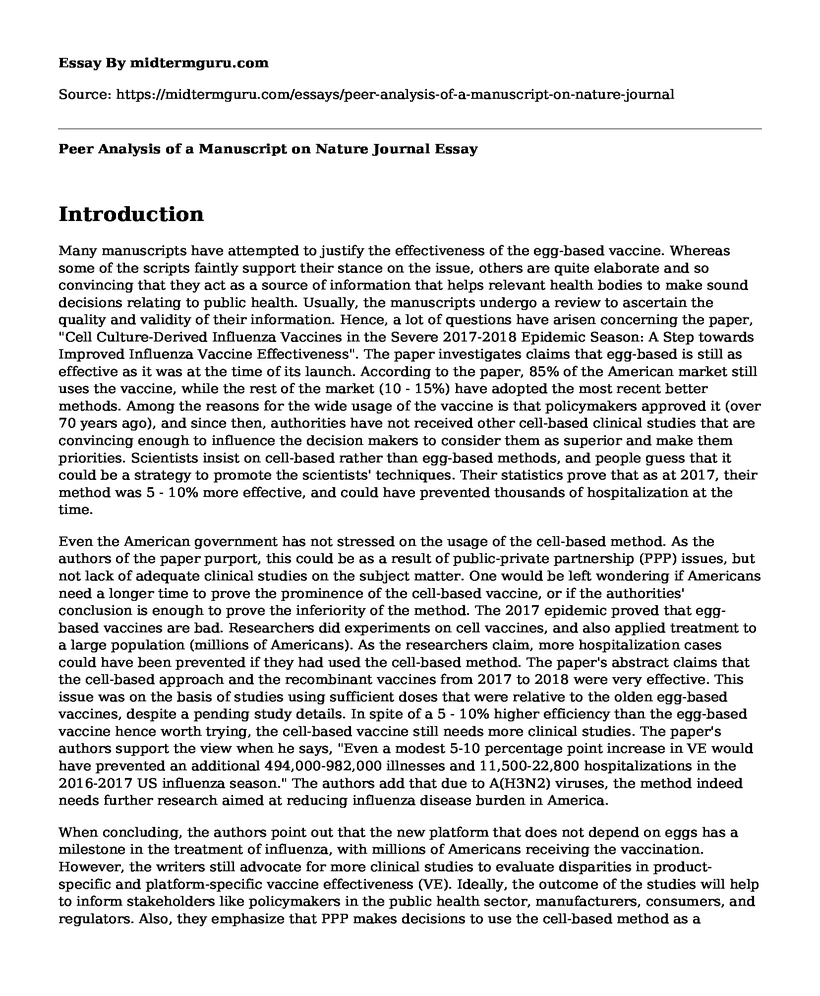Introduction
Many manuscripts have attempted to justify the effectiveness of the egg-based vaccine. Whereas some of the scripts faintly support their stance on the issue, others are quite elaborate and so convincing that they act as a source of information that helps relevant health bodies to make sound decisions relating to public health. Usually, the manuscripts undergo a review to ascertain the quality and validity of their information. Hence, a lot of questions have arisen concerning the paper, "Cell Culture-Derived Influenza Vaccines in the Severe 2017-2018 Epidemic Season: A Step towards Improved Influenza Vaccine Effectiveness". The paper investigates claims that egg-based is still as effective as it was at the time of its launch. According to the paper, 85% of the American market still uses the vaccine, while the rest of the market (10 - 15%) have adopted the most recent better methods. Among the reasons for the wide usage of the vaccine is that policymakers approved it (over 70 years ago), and since then, authorities have not received other cell-based clinical studies that are convincing enough to influence the decision makers to consider them as superior and make them priorities. Scientists insist on cell-based rather than egg-based methods, and people guess that it could be a strategy to promote the scientists' techniques. Their statistics prove that as at 2017, their method was 5 - 10% more effective, and could have prevented thousands of hospitalization at the time.
Even the American government has not stressed on the usage of the cell-based method. As the authors of the paper purport, this could be as a result of public-private partnership (PPP) issues, but not lack of adequate clinical studies on the subject matter. One would be left wondering if Americans need a longer time to prove the prominence of the cell-based vaccine, or if the authorities' conclusion is enough to prove the inferiority of the method. The 2017 epidemic proved that egg-based vaccines are bad. Researchers did experiments on cell vaccines, and also applied treatment to a large population (millions of Americans). As the researchers claim, more hospitalization cases could have been prevented if they had used the cell-based method. The paper's abstract claims that the cell-based approach and the recombinant vaccines from 2017 to 2018 were very effective. This issue was on the basis of studies using sufficient doses that were relative to the olden egg-based vaccines, despite a pending study details. In spite of a 5 - 10% higher efficiency than the egg-based vaccine hence worth trying, the cell-based vaccine still needs more clinical studies. The paper's authors support the view when he says, "Even a modest 5-10 percentage point increase in VE would have prevented an additional 494,000-982,000 illnesses and 11,500-22,800 hospitalizations in the 2016-2017 US influenza season." The authors add that due to A(H3N2) viruses, the method indeed needs further research aimed at reducing influenza disease burden in America.
When concluding, the authors point out that the new platform that does not depend on eggs has a milestone in the treatment of influenza, with millions of Americans receiving the vaccination. However, the writers still advocate for more clinical studies to evaluate disparities in product-specific and platform-specific vaccine effectiveness (VE). Ideally, the outcome of the studies will help to inform stakeholders like policymakers in the public health sector, manufacturers, consumers, and regulators. Also, they emphasize that PPP makes decisions to use the cell-based method as a preference over the egg-based one, to vaccinate the public against flu, as a measure against an influenza pandemic.
Being experts in the research field, the outcomes of their work justifies their conclusion. Therefore, they can advise the public on better health approaches, which would, in turn, translate into a higher cell-based approach usage, and possible prevention of a considerable number of hospitalization. Since the authors' findings are backed up by valid data, the outcomes are justified, and deserve publishing, as a step towards eradicating influenza epidemic. The findings would also help in the implementation of policies that have over time been suppressed. For instance, in 2006, the United States Department of Health and Human Services (HHS) awarded contracts to companies to establish the manufacturing capacity of influenza vaccine with a goal to support response capability for pandemic vaccinations. The program has since then boosted the development of cell-based vaccines, and the creation of recombinant protein-based vaccines. The paper indeed provides a vital explanation to circumstances under which epidemics happen. It also highlights the challenges associated with influenza vaccines. Furthermore, the article raises questions why the cell-based vaccination has only 10-15% popularity when it seems to be the solution. The researchers have used their paper to raise awareness about the need for an effective and universal vaccine. The paper has also called upon manufactures and other researchers to improve the current techniques they use to produce the vaccines currently used. The paper is of public health concern, and relates to everyone, and therefore deserves publishing.
Work Cited
Barr, Ian G., et. al. "Cell Culture-Derived Influenza Vaccines in the Severe 2017-2018 Epidemic Season: A Step towards Improved Influenza Vaccine Effectiveness." NPJ Vaccines 3.1 (2018): 44.
Cite this page
Peer Analysis of a Manuscript on Nature Journal. (2022, Oct 13). Retrieved from https://midtermguru.com/essays/peer-analysis-of-a-manuscript-on-nature-journal
If you are the original author of this essay and no longer wish to have it published on the midtermguru.com website, please click below to request its removal:
- Community Disease Portfolio: Obesity
- Reporting Bias in Nursing Essay Example
- Effects of Technology on Physical Therapy - Paper Example
- The Crossroads Center - Essay Sample
- Case Study on Merger of Two Hospitals
- 19th Century Mystery: Type 2 Diabetes - Essay Sample
- Vaccinations Don't Cause Autism: Argumentative Essay







